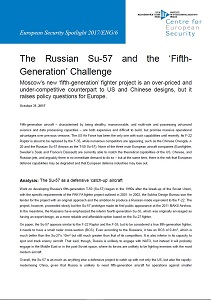The Russian Su-57 and the ‘Fifth-Generation’ Challenge - Moscow’s new ‘fifth-generation’ fighter project is an over-priced and under-competitive counterpart to US and Chinese designs, but it raises policy questions for Europe.
The Russian Su-57 and the ‘Fifth-Generation’ Challenge - Moscow’s new ‘fifth-generation’ fighter project is an over-priced and under-competitive counterpart to US and Chinese designs, but it raises policy questions for Europe.
Author(s): Michael Eric Lambert
Subject(s): International relations/trade, Security and defense, Military policy
Published by: Ústav mezinárodních vztahů
Keywords: Russia; aviation; Su-57; US; China; competitiveness;
Summary/Abstract: Fifth-generation aircraft – characterised by being stealthy, manoeuvrable, and multi-role and possessing advanced avionics and data processing capacities – are both expensive and difficult to build, but promise massive operational advantages over previous versions. The US Air Force has been the only one with such capabilities until recently. Its F-22 Raptor is about to be replaced by the F-35, while numerous competitors are appearing, such as the Chinese Chengdu J20 and the Russian Su-57 (known as the T-50 Su-57). None of the three main European aircraft companies (Eurofighter, Sweden’s Saab and France’s Dassault) are currently able to match the theoretical capabilities of the US, Chinese, and Russian jets, and arguably there is no immediate demand to do so – but at the same time, there is the risk that European defence capabilities may be degraded and that European defence industries may lose out.
Series: European Security Spotlight
- Page Count: 2
- Publication Year: 2017
- Language: English
- Content File-PDF

